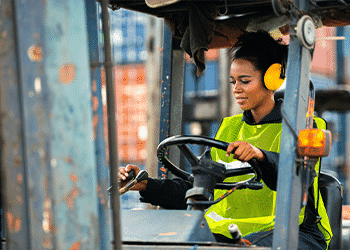Despite changes in working conditions, employers were still responsible for administering all types of training, from safety to job-specific onboarding and even general HR training. Perhaps unsurprisingly, many turned to online training for a solution.
 2022 Online Training Trends: What to Expect in Safety and Beyond
2022 Online Training Trends: What to Expect in Safety and Beyond

Article from | Safety Skills
Over the past year, more than ever before, companies large and small have been looking for ways to update and revamp their training programs. In early 2020, the COVID-19 pandemic forced millions of employees to temporarily — or even permanently — work remotely.
Despite changes in working conditions, employers were still responsible for administering all types of training, from safety to job-specific onboarding and even general HR training. Perhaps unsurprisingly, many turned to online training for a solution.
While training online, at least in some capacity, seems to be the way of the future, there are still yearly training trends that will come and go. So, what will you see in 2022? We will highlight some of the top training techniques for the upcoming year and provide some pointers on choosing the best training partner for you and your company.
What to Expect in 2022
You would be hard-pressed to find a complete list of the training trends that will emerge in the new year, at any time, but here are some of the online training advancements we see gaining momentum that will likely see widespread implementation.
Adaptive learning
In recent years, the term “adaptive learning” has become more commonplace within the training industry, and for good reason. While there is not a set definition, the one most commonly referenced defines adaptive learning as an educational experience that adjusts to a user’s interactions in real time to provide individual support.

Based on the answer or option the user selects during training, the content shown next may differ from that of someone else taking the course. Adaptive learning makes the user an active participant, increasing engagement and also increasing the likelihood the information will be retained once the lesson is complete.
Immersive tech
While you may not have heard of immersive tech, you likely recognize its two main forms: virtual reality (VR) and augmented reality (AR). Simply put, VR uses computer-generated information, or CGI, to provide a sense of full immersion into an experience, while AR blends CGI into the real environment. Both have been around for decades but started gaining mainstream popularity around 2017 and now offer immense benefits to safety training.
For example, VR can be used when training employees on finding defects in required PPE. In a virtual setting, you don’t need to keep faulty equipment around, but employees can still gain that “hands-on” experience. Similarly, an AR overlay can be used on a construction site to see if workers can identify potential safety hazards without having to actually put themselves or others in danger on an active site.
Social learning
This is certainly not a new concept, having been developed as a theory by psychologist Albert Bandura in the 1960s — although it has been in practice for perhaps the entirety of human existence. At its core, social learning states that learning takes place in a social context and can occur purely through observation or direct instruction.

In a workplace training environment, social learning can occur in many ways, from utilizing a company intranet that encourages employees to ask questions, to holding employee-led toolbox talks that allow for regular topical reminders and collaborative teaching moments. No matter how social learning is introduced within an organization, these collective learning experiences help create and solidify a company’s learning culture.
Gamification
Getting employees excited about training, especially over many safety topics, can be difficult, even if your training utilizes relevant and engaging visuals. Recently, gamification has emerged as a way for anyone completing training to more interactively participate by providing game-like functionality and awarding instant gratification.
Gamification can be an effective way to engage learners and get them communicating with their coworkers about the training. For example, using leader boards to display performance during training can, in some situations, drive competition and increase engagement. Remember, however, that simply adding some sort of leaderboard doesn’t necessarily mean employees are actually retaining more of the information. The key is to find a balance between fun, engaging game techniques and effective training methods.
Past Trends Are Still Relevant
While 2022 will surely bring about emerging training trends, as happens each year, there are a few trends from recent years that will continue gaining in popularity and use, and perhaps even more so.
Mobile content
Three or four years ago, mobile-ready content was expected to be one of the biggest training trends, with the proliferation of smartphones and other internet-connected devices among the younger generations. At the time, making sure training content offered the same experience on a desktop computer as on mobile was crucial.

But now, with many “office” workers either no longer or only occasionally in the actual office, plus the continued employment of jobs that are rarely in an office anyway — such as construction, oil and gas, or manufacturing — the mindset has changed from “mobile-ready content” to “mobile-first content.” Developers now look at mobile as the norm, crafting and designing training materials to provide the best experience from any device.
Microlearning
Along with the popularity of smartphones, there has been a corresponding proliferation of social media apps that feature short videos users can upload and share. In the U.S. alone, Snapchat has 105 million users while Instagram has an astounding 159 million. Even the relatively new app TikTok has 80 million monthly users in the U.S.
Microlearning, the common name for short learning modules lasting 5-15 minutes, suits the reality of today’s learners very well. Users are far more likely to stay actively present in a short training video than in a lecture that could last from 30 minutes to over an hour. You can find microlearning as short as three minutes, meaning they get directly to the point without any unnecessary “filler” content that may distract from the key information.
Soft skills
As technological and AI advancements in the workplace continue improving, soft skills become increasingly important, as these cannot be automated. There are a wide variety of useful soft skills, but things like communication and time management are universal and can help boost individual, team and companywide performance.
While so-called hard skills, such as chainsaw operation or scissor lift safety, only apply to specific job functions, soft skills apply to all employees at any level. In fact, according to LinkedIn, 92% of hiring professionals say soft skills matter as much as or more than hard skills, and the inclusion of soft skills in a training curriculum helps create well-rounded employees.
New Changes in Regulations
One of the most important aspects to consider, especially when it comes to safety training, is what OSHA is expected to do in the coming year. While many times this is not definitive, there are a few changes likely coming for OSHA’s next fiscal year (October 2021-September 2022) to pay attention to.

For FY 2022, OSHA requested $28,450,000 for their Safety and Health Standards budget, which includes $10,084,000 toward rulemaking and guidance. They have also requested 155 additional inspectors to add to the current number of about 1,850 inspectors. An increase in budget and inspectors very likely means an increase in the number of OSHA inspections.
The agency also plans to publish five final rules and four proposed rules in the next fiscal year. We already know that one of their rule priorities is regarding Personal Protective Equipment in Construction.
At this point, we don’t know if the changes involve COVID-19 precautions or are simply a general update to requirements. Either way, the changes could significantly impact construction in the field and the current PPE used by construction workers.
No matter what industry you work in, it is always important to keep an eye on the applicable regulatory bodies, whether that be OSHA, DOT, EPA or some other agency, and stay aware of pending changes that could affect how your work is done.
Selecting an Online Training Partner
If your organization decides an online learning management system (LMS) is the right direction, then you need to select the best one for your needs. With hundreds of platforms available, there are many different features you should compare to find your ideal match.
Top-tier content
To be effective, training material must keep the learner’s attention. Illustrating interesting visuals, implementing user-friendly navigation and utilizing relatable scenarios can help keep the training content fun and engaging, which in turn increases knowledge retention.
While training courses need to be engaging, they would be worthless if the content is outdated. Make sure any training content you use is regularly reviewed and updated by the creators to be consistent not only with industry trends but also with changing requirements and regulations.
JHA capabilities
In recent years, the occupational health and safety field has evolved to become more about accident prevention. Safety experts now try to focus on educating employees and identifying potential issues rather than on what is essentially damage control. Depending on your industry and your specific jobsite, there could be any number of different hazards present, including electrical equipment, dangerous goods or heavy machinery.
Conducting a job hazard analysis (JHA) will help you understand the most hazardous jobs in your workplace, what those specific hazards entail, and corrective and preventive measures you can take to reduce or completely eliminate the likelihood of accidents, injuries and illnesses.
Multiple language options
A study conducted by the Center to Protect Workers’ Rights found that workers with limited English proficiency either did not understand a large amount of the provided English-language safety training, or they did not have the language skills to ask questions. Unsurprisingly, when training is offered in an employee’s native language, they are more likely to understand, and retain, the important information.
It makes sense, then, for any training service to have courses available in more than just English. Spanish might be the obvious first thought when it comes to multiple language options, but don’t forget things like German, French, Portuguese or even Mandarin.
Easy reporting tools
Because OSHA inspections can result in potentially serious fines, it is crucial for every employer to understand which incidents need to be tracked for company records, what documentation must be submitted directly to OSHA and anything in between.

Working with an online training partner who understands the importance of maintaining accurate records will help when the inevitable day comes when an OSHA inspector arrives at your door — or when putting together a report on a workplace incident.
Incident management documentation
While OHS has begun putting emphasis on recognizing and eliminating hazards before they can become an issue, accidents do still happen. And when they do, everyone needs to be prepared. Complete and accurate reporting ensures the incident is resolved properly and can show where additional training or safety precautions may be needed.
Unfortunately, not all companies have clear and consistent incident management procedures. Finding a partner who can provide straightforward, easy-to-use documentation will make it easy for any employee, at any level, to understand what steps must be taken. After all, you never know who might be involved in an incident, and therefore who might need to make the official report.
Flexible pricing models
As with any software, pricing for LMS platforms can be somewhat confusing. Look for a system that not only offers a package that works for your needs but one that is transparent in their pricing and does not carry hidden fees for unneeded extras.
Typically, high-quality learning management systems will offer pricing levels per user, per course, or for course licensing. You may also find additional costs for things like implementation and support, but just be sure you are aware of every service you will be paying for.
Don’t Wait to Upgrade Your Training
While we expect to see widespread adoption of each of these trends, it is possible they do not all perfectly align with your needs. We recommend reviewing what would work best for you, your employees and your company to decide how to proceed in the new year.
For more than 20 years, SafetySkills has helped train employees around the world on both workplace and off-the-job hazards, along with numerous HR-compliant topics and valuable soft skills. All our training can be individually assigned so you can create a custom training program.
Contact SafetySkills today to learn more and get a head start on your training as we head into the new year.
The content & opinions in this article are the author’s and do not necessarily represent the views of ManufacturingTomorrow
Comments (0)
This post does not have any comments. Be the first to leave a comment below.
Featured Product

